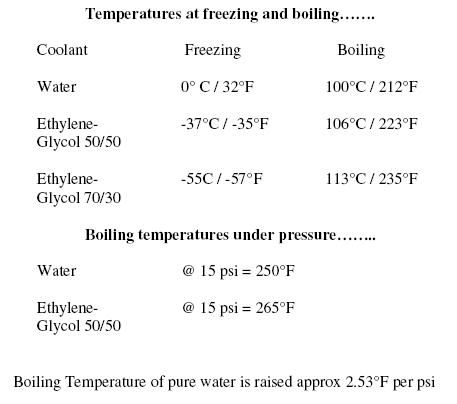Experienced guys on here have reported more success with low pressure caps than vice-versa. The older radiator tanks simply don't like the higher pressures. That said -mine was reworked by a local guy who has done alot of "desert" radiators and he recommended otherwise.
This little chart shows what happens when you mix up your coolant - and change your cap pressure. Makes it possible to predict the temp where your system will decide to boil. Pressure runs up the boiling temperature and reduces the chance of boilover - but don't put some sort of NASCAR 16 pound cap on there - those are way out of our league and will (immediately or eventually) cause structural leaks to the rad.
Yes - check your temp with an infrared temp device, right on the thermostat housing. I always check the outdoor (shade) ambient at the same time for a comparison, as that shows the inlet air temp to the radiator. The difference is a useful number to know - if your system is running over the thermostat setting. Mine often runs 100° over ambient due to the T-bird radiator being small - and the water pump somewhat less than efficent.
If you don't already have one - find a six blade fan for your outfit. Preferably one of the rigid blade variety as slow road speeds, heavy grades, and raised engine rev's will flatten out a flex fan at just the wrong moment. Speedway in Lincoln sells the rigid fans for a decent price (with steel or aluminum blades) and a 5/8 hole to match most waterpumps in passsenger cars.
Testing has shown that the larger poppet thermostats - the "Robertshaw" type mentioned above - can provide a considerable boost in the gallons per minute that circulate through your radiator. This is a pretty cheap upgrade - if you have one of the little thermostats in there. The small ones have about a 1.0 inch poppet with a lot of sheet metal around them - and the large one you want has a 1.50 inch poppet. My personal preference is to use one rated at 180°F opening temperature.

Have a nice summer of crusin'! 